Technology-Driven Transition in Urban Food Production Practices: A Case Study of Shanghai
Abstract
1. Introduction
2. Contribution of ANT to Sociotechnical Transition Studies
2.1. Disentanglement of the Incumbent Regime
2.2. Punctualization Process of Novelties
2.3. Re-Entanglement of Punctualized Actor-Networks and the Creation of a New Sociotechnical Regime
2.4. Gain and Loss in Technology-Driven Transitions
3. Methodology
4. Transition Trajectories in the Food Production System of Shanghai
4.1. Disentanglement of the Existing Food Production Regime
4.1.1. Landscape Pressure
4.1.2. Instability in the Regime
4.1.3. Niche Pressures
4.2. Punctualization of HTUA Practices in the Food Production System
4.2.1. Identification of Involved Actants in the Transition Process toward HTUA
4.2.2. Translation Process of Technological Novelties into Urban Food Production Practices
- Agricultural modernization and concentrated zones for high tech food production through multifunctional land use.
- Coordinated development of urban–rural connections and increased agricultural production capacity.
- Integrated development and modernization of industry, agriculture, defence, and science and technology (S&T) for enhancing agriculture’s supporting role in industrialization and urbanization.
- Development of an R&D infrastructure for HTUA through SOCs and CAAS suborganizations to convince other actants to accept their role in the transition from conventional agriculture to HTUA.
- Policy reformation proposals that assign high priority to the modernization of food and S&T developments in the national and local government agendas.
- Employment of Five-Year Plans, No. 1 Documents, and city titles as intermediaries. Since the 1980s, the Chinese government has awarded various titles to cities (e.g., garden city, healthy city, eco-city, etc.) to encourage the local authorities to develop more sustainable cities [47].
- innovation in urban agriculture practices,
- security and control of agricultural products,
- innovation in using high-efficiency production techniques and low-carbon technology, and
- strategic planning of urban agriculture
4.3. Re-Entanglement of HTUA in the Food Production System and Transition of the Incumbent Regime
5. Discussion
5.1. Empirical Findings
5.2. Theoretical and Methodological Implications
6. Conclusions
Author Contributions
Funding
Conflicts of Interest
Appendix A
| Policy documents and agendas | 12th Five-Year Plan (2011–2015) |
| 13th Five-Year Plan (2016–2020) | |
| China’s 2015 Central Policy Document No. 1 | |
| China’s 2016 Central Policy Document No. 1 | |
| China’s 2017 Central Policy Document No. 1 | |
| China’s Agricultural Modernization – Information Sheet No. 6 | |
| China’s strategy for ecological agricultural development | |
| Agenda for sustainable development | |
| Action plans and programs | Vegetable basket program |
| Agricultural Science and Technology Innovation Program | |
| Three-dimensional greening | |
| 12th National modern agriculture development plan 2011–2105 | |
| 13th National Sustainable Agricultural Development plan 2016–2020 | |
| 13th National modern agriculture development plan 2016–2020 | |
| Three-Year Plan on ‘’internet plus’’ modern agriculture | |
| National plan on new urbanization 2014–2020 | |
| National sustainable agricultural development plan 2015–2030 | |
| Green building action plan No.1 document |
Appendix B
| Site visits | CAAS plant factory |
| Knowledge and innovation community gardens | |
| Sunqiao modern agriculture zone | |
| Shanghai community garden centre | |
| Events | Pop-up event, Edible Cities Dedodesign |
| Initiatives at New York University | |
| Tongji regeneration of Shanghai and vertical greening congress | |
| Tongji landscape group presentation on innovative urban food production | |
| Meetings | Tongji-Plantagon meetings |
| Researchers’ nights at Euraxess | |
| R&D collaborations | Mocele farm |
| Veggiepal | |
| Innovative urban green | |
| Best green life – vertical greening solutions |
Appendix C
| Interviewee | Position | Affiliation | Location | Date |
|---|---|---|---|---|
| SH-01 | Professor, Entrepreneur | Tongji University, Knowledge & Innovation and community garden, Government-organized non-governmental organization | Shanghai | Sep. 2016 |
| SH-02 | Entrepreneur | Lifestylegreen (SME) | Shanghai | Oct. 2016 |
| SH-03 | Entrepreneur | VeggiePal (Startup) | Shanghai | Oct. 2016 |
| SH-04 | Professor | Tongji | Shanghai | Nov. 2016 |
| SH-05 | Professor | Tongji | Shanghai | Nov. 2016 |
| SH-06 | Professor | Tongji | Shanghai | Nov. 2016 |
| SH-07 | Manager | Knowledge & Innovation and community garden | Shanghai | Nov. 2016 |
| SH-08 | Director | Knowledge & Innovation and community garden | Shanghai | Nov. 2016 |
| SH-09 | Professor | Tongji-Plantagon research centre | Shanghai | Nov. 2016 |
| SH-10 | Professor | Tongji | Shanghai | Nov. 2016 |
| SH-11 | Professor | Tongji | Shanghai | Dec. 2016 |
| SH-12 | Director | Innovative urban Green | Shanghai – informal discussion | Dec. 2016 |
| SH-13 | Entrepreneur | Foreign Start-up, Vegger | Shanghai | Dec. 2016 |
| SH-14 | Professor | Jiaotong, KLUS | Shanghai – informal discussion | Dec. 2016 |
| SH-15 | Entrepreneur | Urban Farms | Shanghai – informal discussion | Dec. 2016 |
| SH-16 | Entrepreneur | Dedodesign | Shanghai | Dec. 2016 |
| SH-17 | Professor | Tongji | Shanghai | Dec. 2016 |
| SH-18 | Founder | Mocle farm | Shanghai | Dec. 2016 |
| SH-19 | Entrepreneur | Zuzi Technology Co., Ltd, | Shanghai – informal discussion | Dec. 2016 |
| SH-20 | CEO | Tongji-Plantagon | Shanghai – informal discussion | Jan. 2017 |
| SH-21 | Chief Planner | Sasaki | Online | Jan. 2018 |
| SH-22 | Planner | Sasaki | Online | Jan. 2018 |
| SH-23 | PR | Shanghai Pudong Agricultural Development Group | Online | Jan. 2018 |
| SH-24 | Researcher | CAAS | Online | Jan. 2018 |
Appendix D
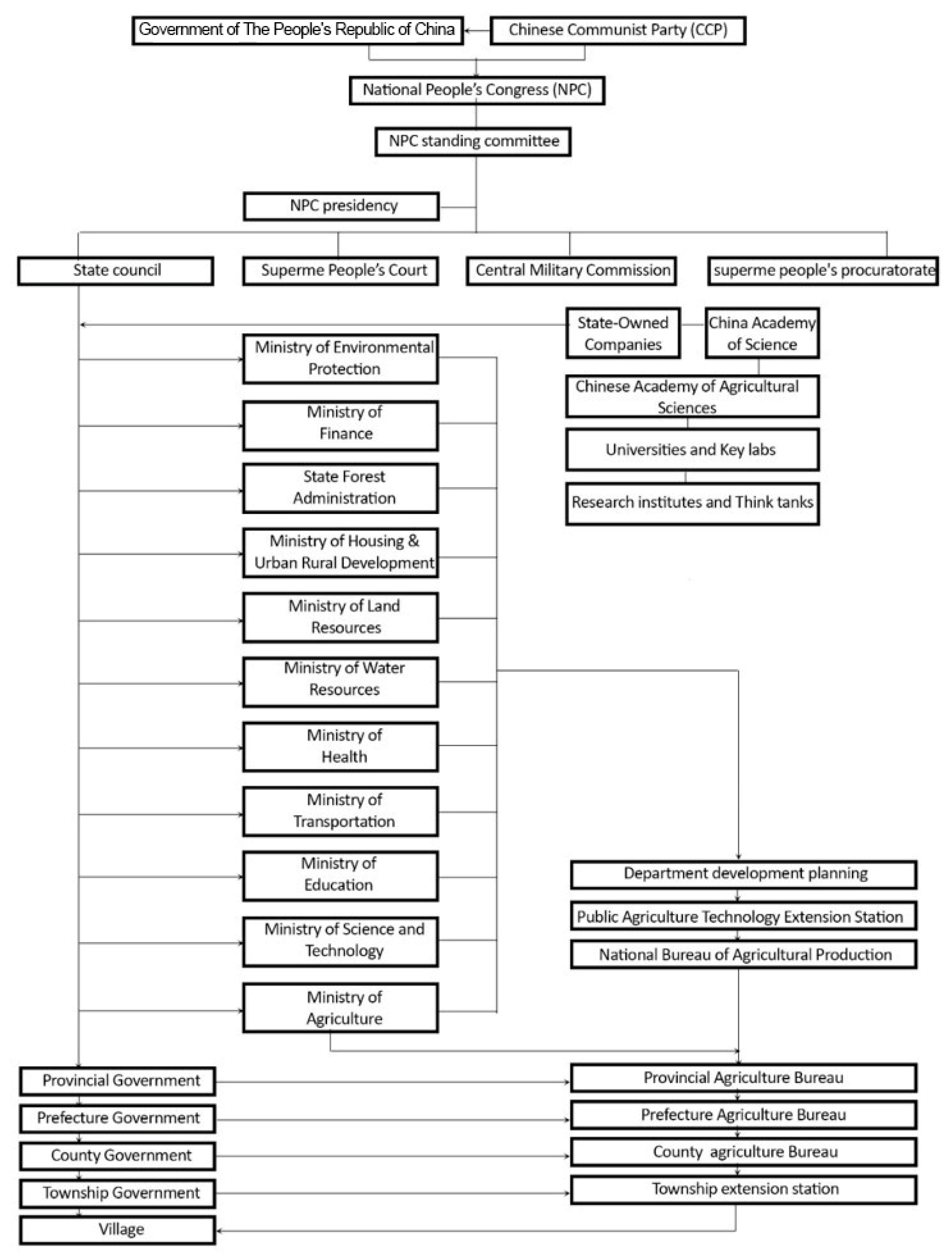
Appendix E
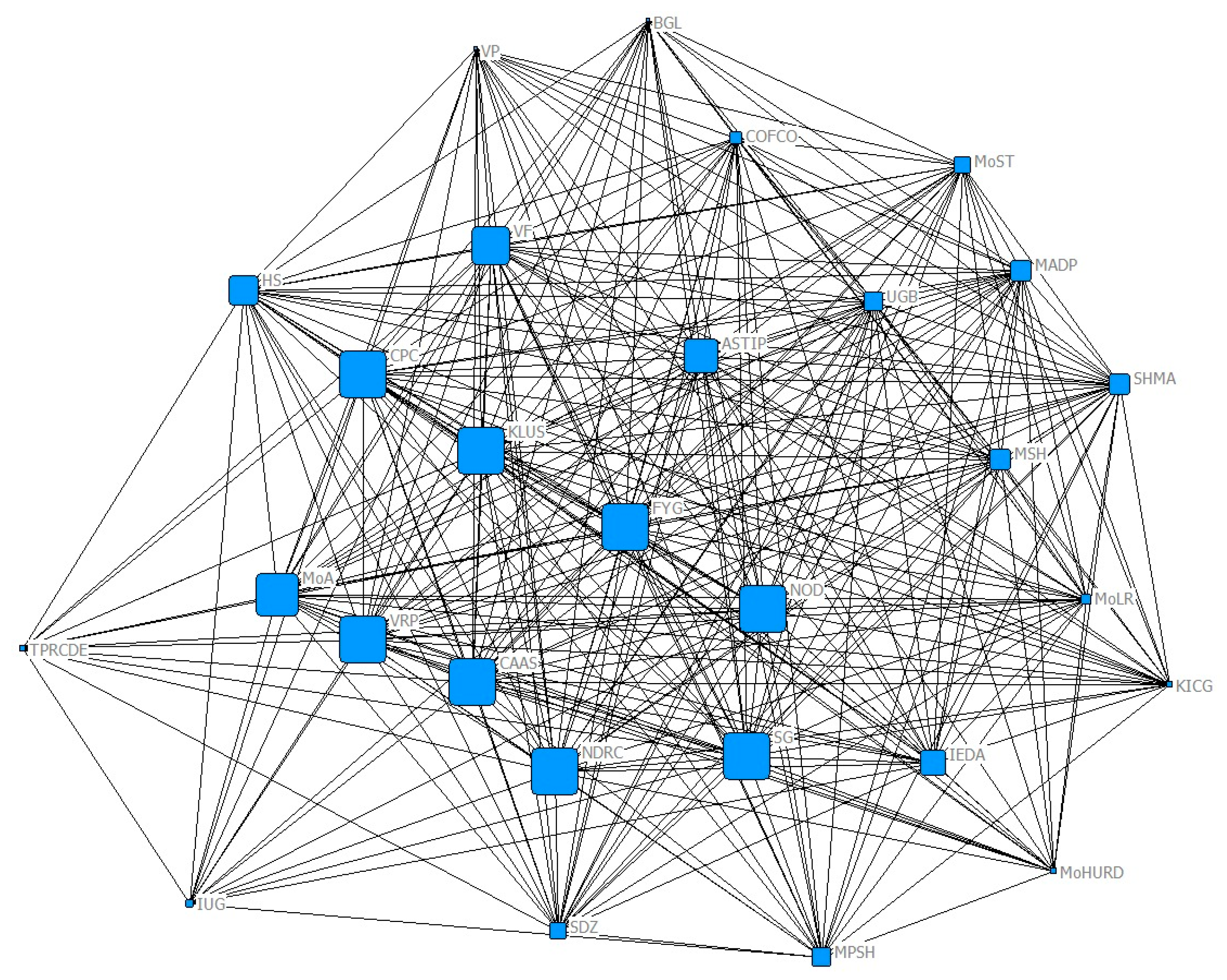
Appendix F
| SG | CAAS | IEDA | NDRC | MoA | MoHURD | MoST | MoLR | MSH | SHMA | COFCO | FYP | NOD | VP | |
|---|---|---|---|---|---|---|---|---|---|---|---|---|---|---|
| SG | 0 | 5 | 3 | 4 | 6 | 6 | 6 | 6 | 5 | 3 | 5 | 4 | 3 | 3 |
| CAAS | 5 | 0 | 6 | 5 | 6 | 4 | 5 | 4 | 4 | 4 | 5 | 4 | 5 | 6 |
| IEDA | 3 | 6 | 0 | 2 | 3 | 2 | 4 | 2 | 2 | 3 | 4 | 3 | 3 | 4 |
| NDRC | 4 | 5 | 2 | 0 | 5 | 5 | 5 | 5 | 3 | 4 | 4 | 5 | 5 | 3 |
| MoA | 6 | 6 | 3 | 5 | 0 | 3 | 3 | 3 | 3 | 3 | 6 | 5 | 5 | 3 |
| MoHURD | 6 | 4 | 2 | 5 | 3 | 0 | 3 | 3 | 5 | 6 | 1 | 5 | 2 | 1 |
| MoST | 6 | 5 | 4 | 5 | 3 | 3 | 0 | 3 | 3 | 3 | 4 | 5 | 3 | 2 |
| MoLR | 6 | 4 | 2 | 5 | 3 | 3 | 3 | 0 | 5 | 5 | 3 | 5 | 5 | 1 |
| MSH | 5 | 4 | 2 | 3 | 3 | 5 | 3 | 5 | 0 | 6 | 3 | 5 | 4 | 4 |
| SHMA | 3 | 4 | 3 | 4 | 3 | 6 | 3 | 5 | 6 | 0 | 2 | 5 | 3 | 3 |
| COFCO | 5 | 5 | 4 | 4 | 6 | 1 | 4 | 3 | 3 | 2 | 0 | 2 | 4 | 3 |
| FYP | 4 | 4 | 3 | 5 | 5 | 5 | 5 | 5 | 5 | 5 | 2 | 0 | 3 | 3 |
| NOD | 3 | 5 | 3 | 5 | 5 | 2 | 3 | 5 | 4 | 3 | 4 | 3 | 0 | 3 |
| VP | 3 | 6 | 4 | 3 | 3 | 1 | 2 | 1 | 4 | 3 | 3 | 3 | 3 | 0 |
| BGL | 3 | 4 | 1 | 3 | 2 | 1 | 2 | 3 | 3 | 3 | 2 | 2 | 2 | 1 |
| SDZ | 3 | 5 | 3 | 3 | 3 | 1 | 3 | 4 | 5 | 4 | 3 | 4 | 4 | 1 |
| TPRCDE | 3 | 5 | 1 | 2 | 4 | 1 | 1 | 1 | 1 | 1 | 1 | 2 | 2 | 1 |
| KICG | 3 | 4 | 2 | 3 | 5 | 1 | 2 | 1 | 6 | 3 | 1 | 3 | 3 | 1 |
| IUG | 3 | 4 | 2 | 2 | 4 | 1 | 1 | 1 | 1 | 1 | 1 | 2 | 2 | 1 |
| HS | 2 | 6 | 5 | 3 | 3 | 1 | 4 | 1 | 3 | 3 | 5 | 2 | 3 | 5 |
| VF | 2 | 6 | 5 | 4 | 3 | 1 | 4 | 2 | 4 | 3 | 5 | 2 | 3 | 5 |
| VRP | 4 | 5 | 5 | 5 | 5 | 3 | 2 | 3 | 5 | 5 | 3 | 3 | 4 | 4 |
| UGB | 3 | 5 | 4 | 5 | 3 | 3 | 1 | 3 | 6 | 6 | 2 | 3 | 4 | 4 |
| ASTIP | 4 | 5 | 4 | 5 | 5 | 2 | 4 | 2 | 3 | 2 | 3 | 5 | 6 | 3 |
| CPC | 6 | 6 | 3 | 5 | 5 | 5 | 5 | 5 | 3 | 3 | 6 | 6 | 6 | 2 |
| MPSH | 5 | 3 | 1 | 4 | 1 | 5 | 1 | 5 | 5 | 6 | 2 | 5 | 4 | 1 |
| MADP | 4 | 3 | 2 | 5 | 3 | 3 | 2 | 3 | 5 | 6 | 2 | 4 | 4 | 2 |
| KLUS | 3 | 6 | 5 | 2 | 4 | 4 | 3 | 3 | 3 | 3 | 3 | 3 | 4 | 3 |
| BGL | SDZ | TPRCDE | KICG | IUG | HS | VF | VRP | UGB | ASTIP | CPC | MPSH | MADP | KLUS | |
| SG | 3 | 5 | 3 | 3 | 3 | 2 | 2 | 4 | 3 | 4 | 6 | 5 | 4 | 3 |
| CAAS | 4 | 5 | 5 | 4 | 4 | 6 | 6 | 5 | 5 | 5 | 6 | 3 | 3 | 6 |
| IEDA | 1 | 3 | 1 | 2 | 2 | 5 | 5 | 5 | 4 | 4 | 3 | 1 | 2 | 5 |
| NDRC | 3 | 3 | 2 | 3 | 2 | 3 | 4 | 5 | 5 | 5 | 5 | 4 | 5 | 2 |
| MoA | 2 | 3 | 4 | 5 | 4 | 3 | 3 | 5 | 3 | 5 | 5 | 1 | 3 | 4 |
| MoHURD | 1 | 1 | 1 | 1 | 1 | 1 | 1 | 3 | 3 | 2 | 5 | 5 | 3 | 4 |
| MoST | 2 | 3 | 1 | 2 | 1 | 4 | 4 | 2 | 1 | 4 | 5 | 1 | 2 | 3 |
| MoLR | 3 | 4 | 1 | 1 | 1 | 1 | 2 | 3 | 3 | 2 | 5 | 5 | 3 | 3 |
| MSH | 3 | 5 | 1 | 6 | 1 | 3 | 4 | 5 | 6 | 3 | 3 | 5 | 5 | 3 |
| SHMA | 3 | 4 | 1 | 3 | 1 | 3 | 3 | 5 | 6 | 2 | 3 | 6 | 6 | 3 |
| COFCO | 2 | 3 | 1 | 1 | 1 | 5 | 5 | 3 | 2 | 3 | 6 | 2 | 2 | 3 |
| FYP | 2 | 4 | 2 | 3 | 2 | 2 | 2 | 3 | 3 | 5 | 6 | 5 | 4 | 3 |
| NOD | 2 | 4 | 2 | 3 | 2 | 3 | 3 | 4 | 4 | 6 | 6 | 4 | 4 | 4 |
| VP | 1 | 1 | 1 | 1 | 1 | 5 | 5 | 4 | 4 | 3 | 2 | 1 | 2 | 3 |
| BGL | 0 | 1 | 1 | 1 | 1 | 5 | 5 | 4 | 4 | 3 | 2 | 1 | 2 | 2 |
| SDZ | 1 | 0 | 2 | 1 | 1 | 5 | 5 | 5 | 5 | 4 | 3 | 4 | 5 | 4 |
| TPRCDE | 1 | 2 | 0 | 1 | 2 | 5 | 5 | 2 | 1 | 2 | 2 | 1 | 1 | 4 |
| KICG | 1 | 1 | 1 | 0 | 1 | 4 | 4 | 5 | 5 | 2 | 2 | 3 | 3 | 3 |
| IUG | 1 | 1 | 2 | 1 | 0 | 4 | 4 | 2 | 1 | 1 | 2 | 2 | 1 | 4 |
| HS | 5 | 5 | 5 | 4 | 4 | 0 | 6 | 3 | 2 | 4 | 2 | 1 | 2 | 5 |
| VF | 5 | 5 | 5 | 4 | 4 | 6 | 0 | 5 | 4 | 4 | 2 | 2 | 3 | 5 |
| VRP | 3 | 5 | 2 | 5 | 2 | 3 | 5 | 0 | 6 | 2 | 3 | 3 | 4 | 3 |
| UGB | 3 | 5 | 1 | 5 | 1 | 2 | 4 | 6 | 0 | 2 | 3 | 4 | 5 | 3 |
| ASTIP | 3 | 3 | 2 | 2 | 1 | 4 | 4 | 2 | 2 | 0 | 5 | 3 | 5 | 5 |
| CPC | 2 | 3 | 2 | 2 | 2 | 2 | 2 | 3 | 3 | 5 | 0 | 3 | 3 | 2 |
| MPSH | 1 | 4 | 1 | 3 | 2 | 1 | 2 | 3 | 4 | 3 | 3 | 0 | 5 | 2 |
| MADP | 2 | 5 | 1 | 3 | 1 | 2 | 3 | 4 | 5 | 5 | 3 | 5 | 0 | 4 |
| KLUS | 2 | 4 | 4 | 3 | 4 | 5 | 5 | 3 | 3 | 5 | 2 | 2 | 4 | 0 |
References
- Shi, K.; Chen, Y.; Yu, B.; Xu, T.; Li, L.; Huang, C.; Liu, R.; Chen, Z.; Wu, J. Urban expansion and agricultural land loss in China: A multiscale perspective. Sustainability 2016, 8, 790. [Google Scholar] [CrossRef]
- Li, Z.; Ma, Z.; van der Kuijp, T.J.; Yuan, Z.; Huang, L. A review of soil heavy metal pollution from mines in China: Pollution and health risk assessment. Sci. Total Environ. 2014, 468, 843–853. [Google Scholar] [CrossRef]
- Ju, X.T.; Xing, G.X.; Chen, X.P.; Zhang, S.L.; Zhang, L.J.; Liu, X.J.; Cui, Z.L.; Yin, B.; Christie, P.; Zhu, Z.L.; et al. Reducing environmental risk by improving N management in intensive Chinese agricultural systems. Proc. Natl. Acad. Sci. USA 2009, 106, 3041–3046. [Google Scholar] [CrossRef]
- Cui, L.; Shi, J. Urbanization and its environmental effects in Shanghai, China. Urban Clim. 2012, 2, 1–5. [Google Scholar] [CrossRef]
- Yang, C. On the Difference and Coordination of the Social Security System in the Urban and Rural Areas of China. J. Zhejiang Univ. (Humanit. Soc. Sci.) 2004, 3, 19–34. [Google Scholar]
- Barbosa, G.; Gadelha, F.; Kublik, N.; Proctor, A.; Reichelm, L.; Weissinger, E.; Wohlleb, G.; Halden, R. Comparison of land, water, and energy requirements of lettuce grown using hydroponic vs. conventional agricultural methods. Int. J. Environ. Res. Public Health 2015, 12, 6879–6891. [Google Scholar] [CrossRef]
- Bayley, J.E.; Yu, M.; Frediani, K. Sustainable food production using high density vertical growing (verticrop¿). In Proceedings of the XXVIII International Horticultural Congress on Science and Horticulture for People (IHC2010): International Symposium 921, Lisbon, Portugal, 22 August 2010; pp. 95–104. [Google Scholar]
- Benke, K.; Tomkins, B. Future food-production systems: Vertical farming and controlled-environment agriculture. Sustain. Sci. Pract. Policy 2017, 13, 13–26. [Google Scholar] [CrossRef]
- Despommier, D. The Vertical Farm: Feeding the World in the 21st Century; St. Martin’s Press: New York, NY, USA, 2010. [Google Scholar]
- Graamans, L.; Baeza, E.; Van Den Dobbelsteen, A.; Tsafaras, I.; Stanghellini, C. Plant factories versus greenhouses: Comparison of resource use efficiency. Agric. Syst. 2018, 160, 31–43. [Google Scholar] [CrossRef]
- Molin, E.; Martin, M. Assessing the energy and environmental performance of vertical hydroponic farming. IVL Swed. Environ. Res. Inst. 2018, 2018, 36. [Google Scholar]
- Perkins, D.H. Agricultural Development in China, 1368–1968; Routledge: New York, NY, USA, 2017. [Google Scholar]
- Sasaki. Sunqiao Urban Agricultural District. Available online: http://www.sasaki.com/project/417/sunqiao-urban-agricultural-district/ (accessed on 15 August 2017).
- Cao, C.; Suttmeier, R.P.; Simon, D.F. China’s 15-year science and technology plan. Phys. Today 2006, 59, 38. [Google Scholar] [CrossRef]
- Chen, J. Rapid urbanization in China: A real challenge to soil protection and food security. Catena 2007, 69, 1–5. [Google Scholar] [CrossRef]
- Callon, M.; Blackwell, O. Actor-Network Theory; The Politics of Interventions, Oslo Academic Press: Unipub, Oslo, 2007; pp. 273–286. [Google Scholar]
- Frohmann, B. Taking information policy beyond information science: Applying the actor network theory. In Proceedings of the Annual Conference of the Canadian Association for Information Science, University of Alberta, Edmonton, AB, Canada, 7 June 1995; Volume 23, pp. 7–10. [Google Scholar]
- Rydin, Y. Using Actor–Network Theory to understand planning practice: Exploring relationships between actants in regulating low-carbon commercial development. Plan. Theory 2013, 12, 23–45. [Google Scholar] [CrossRef]
- Farías, I.; Bender, T. Urban Assemblages: How Actor-Network Theory Changes Urban Studies; Routledge: New York, NY, USA, 2012. [Google Scholar]
- Geels, F.W. The multi-level perspective on sustainability transitions: Responses to seven criticisms. Environ. Innov. Soc. Transit. 2011, 1, 24–40. [Google Scholar] [CrossRef]
- Whitmarsh, L. How useful is the Multi-Level Perspective for transport and sustainability research? J. Transp. Geogr. 2012, 24, 483–487. [Google Scholar] [CrossRef]
- Geels, F.W. Technological transitions as evolutionary reconfiguration processes: A multi-level perspective and a case-study. Res. Policy 2002, 31, 1257–1274. [Google Scholar] [CrossRef]
- Geels, F.W.; Schot, J. Typology of sociotechnical transition pathways. Res. Policy 2007, 36, 399–417. [Google Scholar] [CrossRef]
- Weaver, P.M.; Rotmans, J. Integrated sustainability assessment: What is it, why do it and how? Int. J. Innov. Sustain. Dev. 2006, 1, 284–303. [Google Scholar] [CrossRef]
- Avelino, F.; Rotmans, J. Power in transition: An interdisciplinary framework to study power in relation to structural change. Eur. J. Soc. Theory 2009, 12, 543–569. [Google Scholar] [CrossRef]
- Spaargaren, G.; Oosterveer, P.; Loeber, A. (Eds.) Food Practices in Transition: Changing Food Consumption, Retail and Production in the Age of Reflexive Modernity; Routledge: New York, NY, USA, 2013. [Google Scholar]
- Smith, A.; Stirling, A.; Berkhout, F. The governance of sustainable socio-technical transitions. Res. Policy 2005, 34, 1491–1510. [Google Scholar] [CrossRef]
- Melian, C.; Mähring, M. Lost and gained in translation: Adoption of open source software development at Hewlett-Packard. In Proceedings of the IFIP International Conference on Open Source Systems, Milan, Italy, 7 September 2008; Springer: Boston, MA, USA, 2008; pp. 93–104. [Google Scholar]
- Genus, A.; Coles, A.M. Rethinking the multi-level perspective of technological transitions. Res. Policy 2008, 37, 1436–1445. [Google Scholar] [CrossRef]
- Cressman, D. A Brief Overview of Actor-Network Theory: Punctualization, Heterogeneous Engineering & Translation; Summit, Simon Fraster University: Burnaby, BC, Canada, April 2019. [Google Scholar]
- Latour, B. On interobjectivity. MindCult. Act. 1996, 3, 228–245. [Google Scholar] [CrossRef]
- Cvetinovic, M.; Nedovic-Budic, Z.; Bolay, J.C. Decoding urban development dynamics through actor-network methodological approach. Geoforum 2017, 82, 141–157. [Google Scholar] [CrossRef]
- Callon, M. Society in the making: The study of technology as a tool for sociological analysis. In The Social Construction of Technological Systems: New Directions in the Sociology and History of Technology; The MIT Press: Cambridge, MA, USA, 1987; pp. 83–103. [Google Scholar]
- Harman, G. Prince of Networks: Bruno Latour and Metaphysics; re. Press: Victoria, Australia, 2010. [Google Scholar]
- Edward, M. From Actor Network Theory to Modes of Existence: Latour’s Ontologies; Global Discourse 6 (1–2); Routledge: Newcastle, UK, 2016; pp. 1–7. [Google Scholar]
- Callon, M.; Law, J.; Rip, A. How to study the force of science. In Mapping the Dynamics of Science and Technology; Palgrave Macmillan: London, UK, 1986; pp. 3–15. [Google Scholar]
- Latour, B. Science in Action: How to Follow Scientists and Engineers through Society; Harvard University Press: Harvard, MA, USA, 1987. [Google Scholar]
- Law, J. Notes on the theory of the actor-network: Ordering, strategy, and heterogeneity. Syst. Pract. 1992, 5, 379–393. [Google Scholar] [CrossRef]
- Latour, B. Reassembling the Social. An Introduction to Actor-Network-Theory; Oxford University Press: New York, NY, USA, 2005. [Google Scholar]
- Putnik, G.D. Encyclopedia of Networked and Virtual Organizations; Information Science Reference (an imprint of IGI Global): New York, NY, USA, 2008. [Google Scholar]
- Callon, M. Some elements of a sociology of translation: Domestication of the scallops and the fishermen of St Brieuc Bay. Sociol. Rev. 1984, 32 (Suppl. 1), 196–233. [Google Scholar] [CrossRef]
- Yin, R.K. Applications of Case Study Research; Sage: London, UK, 2011. [Google Scholar]
- Cerulo, K.A. Nonhumans in social interaction. Annu. Rev. Sociol. 2009, 35, 531–552. [Google Scholar] [CrossRef]
- Rydin, Y.; Tate, L. (Eds.) Actor Networks of Planning: Exploring the Influence of Actor Network Theory; Routledge: New York, NY, USA, 2016. [Google Scholar]
- Rydin, Y. Actor-network theory and planning theory: A response to Boelens. Plan. Theory 2010, 9, 265–268. [Google Scholar] [CrossRef]
- Zhao, J. Exploration and practices of China’s urban development models. In Towards Sustainable Cities in China; Springer: New York, NY, USA, 2011; pp. 15–36. [Google Scholar]
- Miller, A. Scaling Up or Selling Out? A Critical Appraisal of Current Developments in Vertical Farming. Ph.D. Thesis, Carleton University, Ottawa, ON, Canada, 2011. [Google Scholar]
- Hallock, L.S. Vertical Farms, Urban Restructuring and the Rise of Capitalist Urban Agriculture. Ph.D. Thesis, International Institute of Social Studies, The Hague, The Netherlands, 2013. [Google Scholar]
- Cai, Y.-Z.; Zhang, Z. Shanghai: Trends towards specialised and capital-intensive urban agriculture. In Growing Cities Growing Food: Urban Agriculture on the Policy Agenda, Feldafing, Deutsche Stiftung fur Internationale Entwicklung (DSE); Zentralstelle fur Ernahrung und Landwirtschaft: Feldafing, Germany, 2000; pp. 467–477. [Google Scholar]
- Cai, J.; Yang, Z.; Liu, S.; Liu, M.; Guo, H.; Du, S. Urban agriculture development in Minhang, Shanghai. Urban Agric. Mag. 2011, 25, 2060–2062. [Google Scholar]
- Deng, C.X.; Xie, B.G.; Wu, Y.X.; Li, X.; Zhu, D. Quantitative and comprehensive evaluation of ecological security of urban agriculture in Shanghai. Geogr. Res. 2011, 30, 645–654. [Google Scholar]
- Billger, M.; Thuvander, L.; Wästberg, B.S. In search of visualization challenges: The development and implementation of visualization tools for supporting dialogue in urban planning processes. Environ. Plan. B Urban Anal. City Sci. 2017, 44, 1012–1035. [Google Scholar] [CrossRef]
- Tietjen, A.; Jørgensen, G. Translating a wicked problem: A strategic planning approach to rural shrinkage in Denmark. Landsc. Urban Plan. 2016, 154, 29–43. [Google Scholar] [CrossRef]
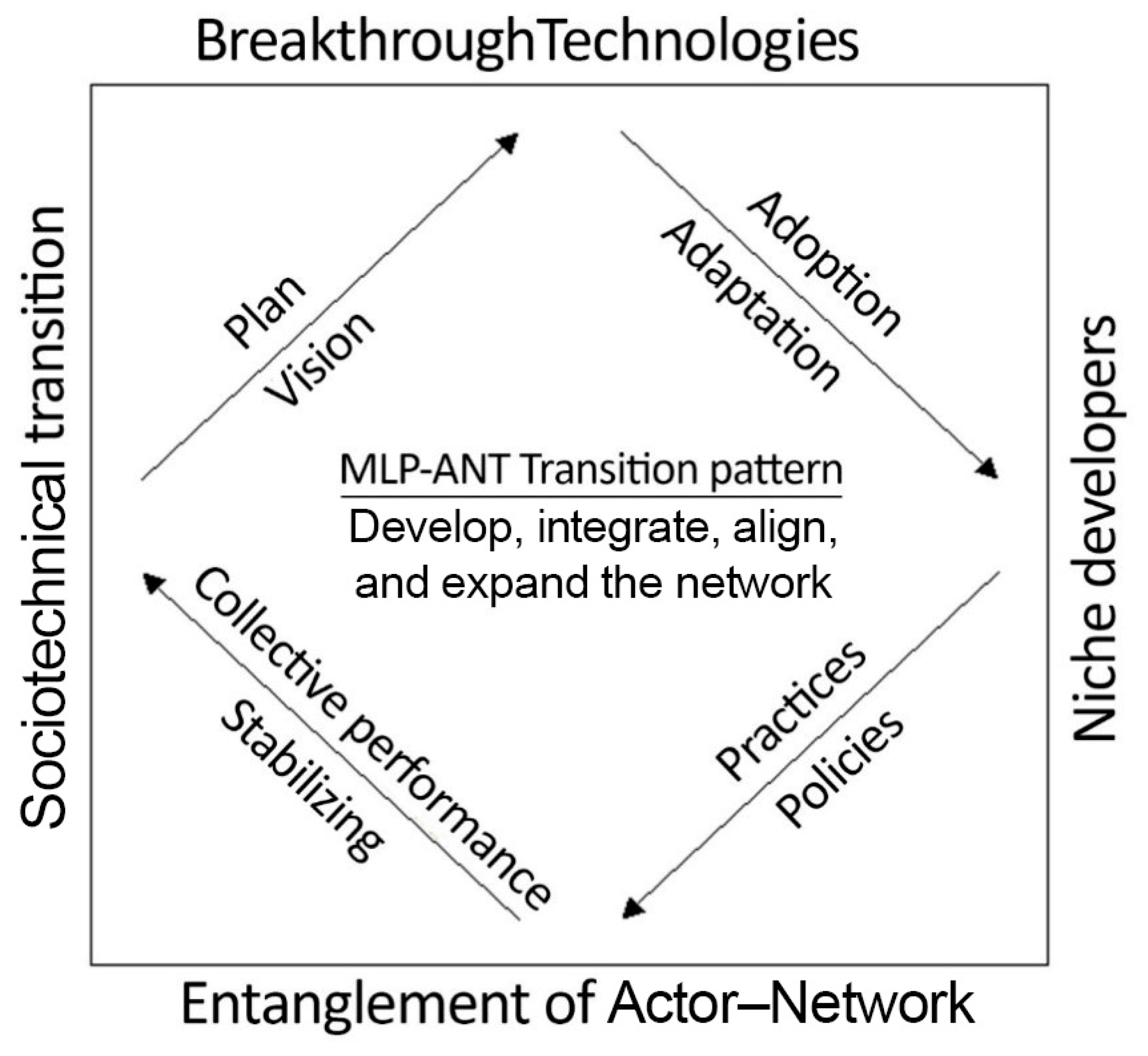
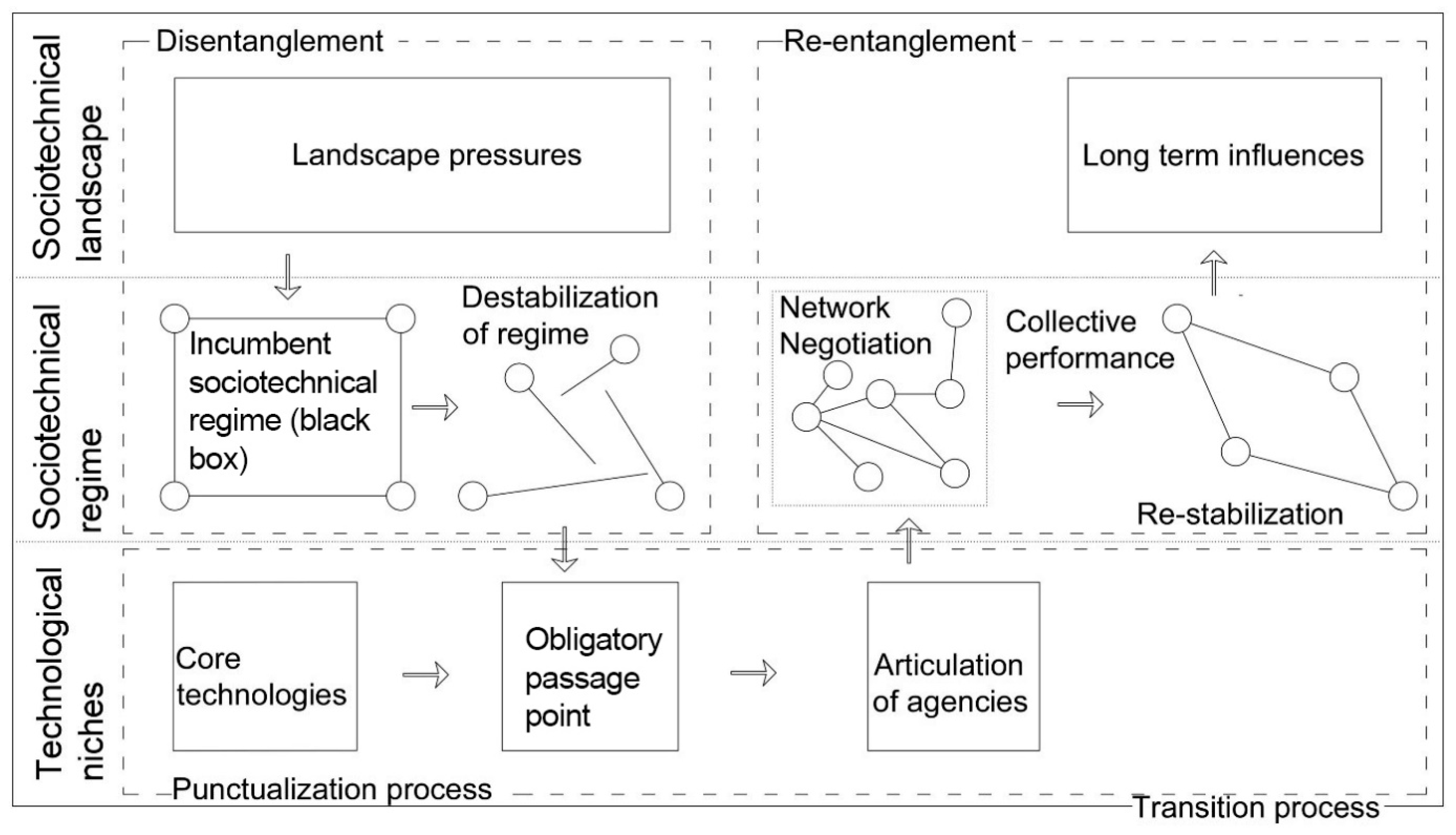

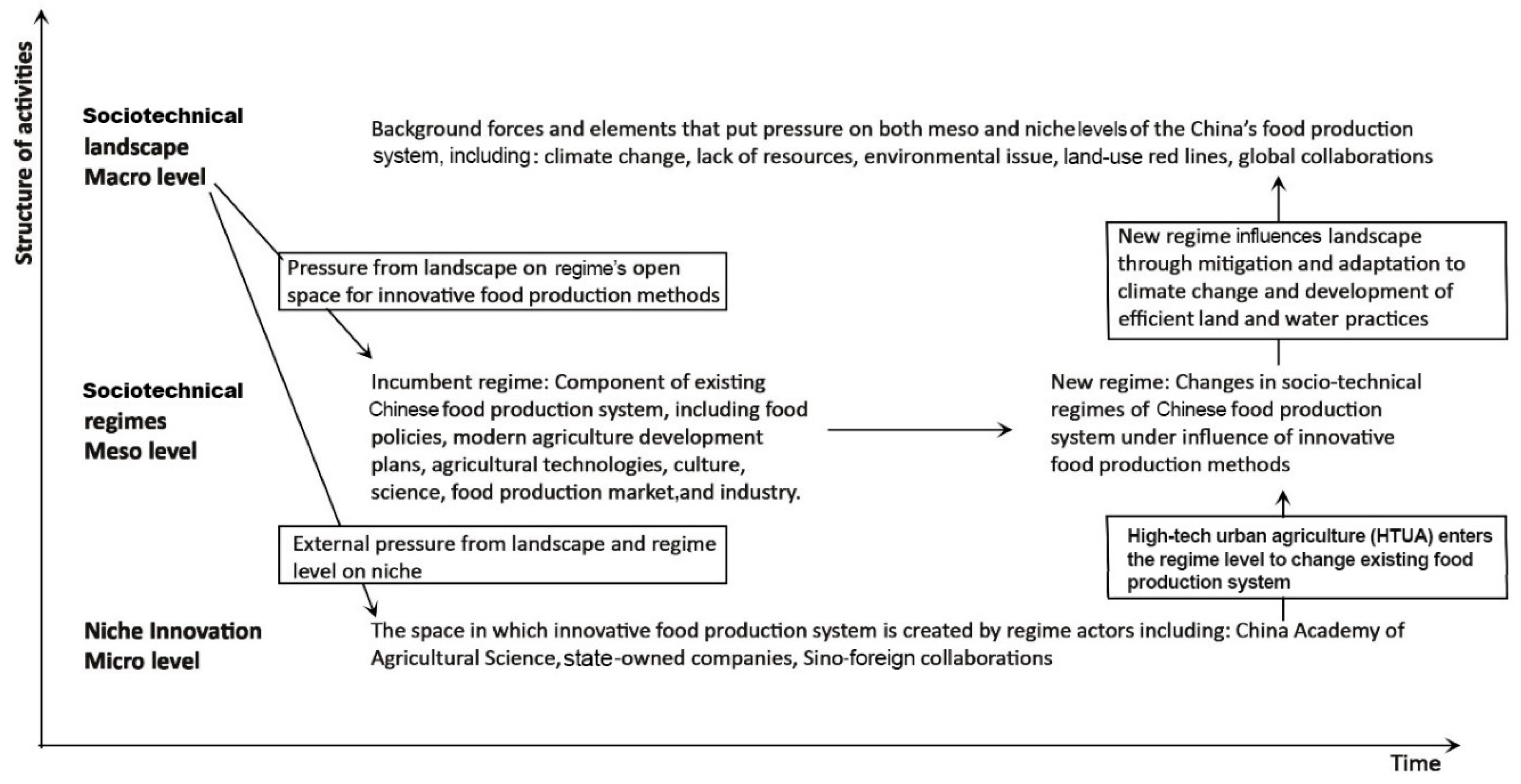
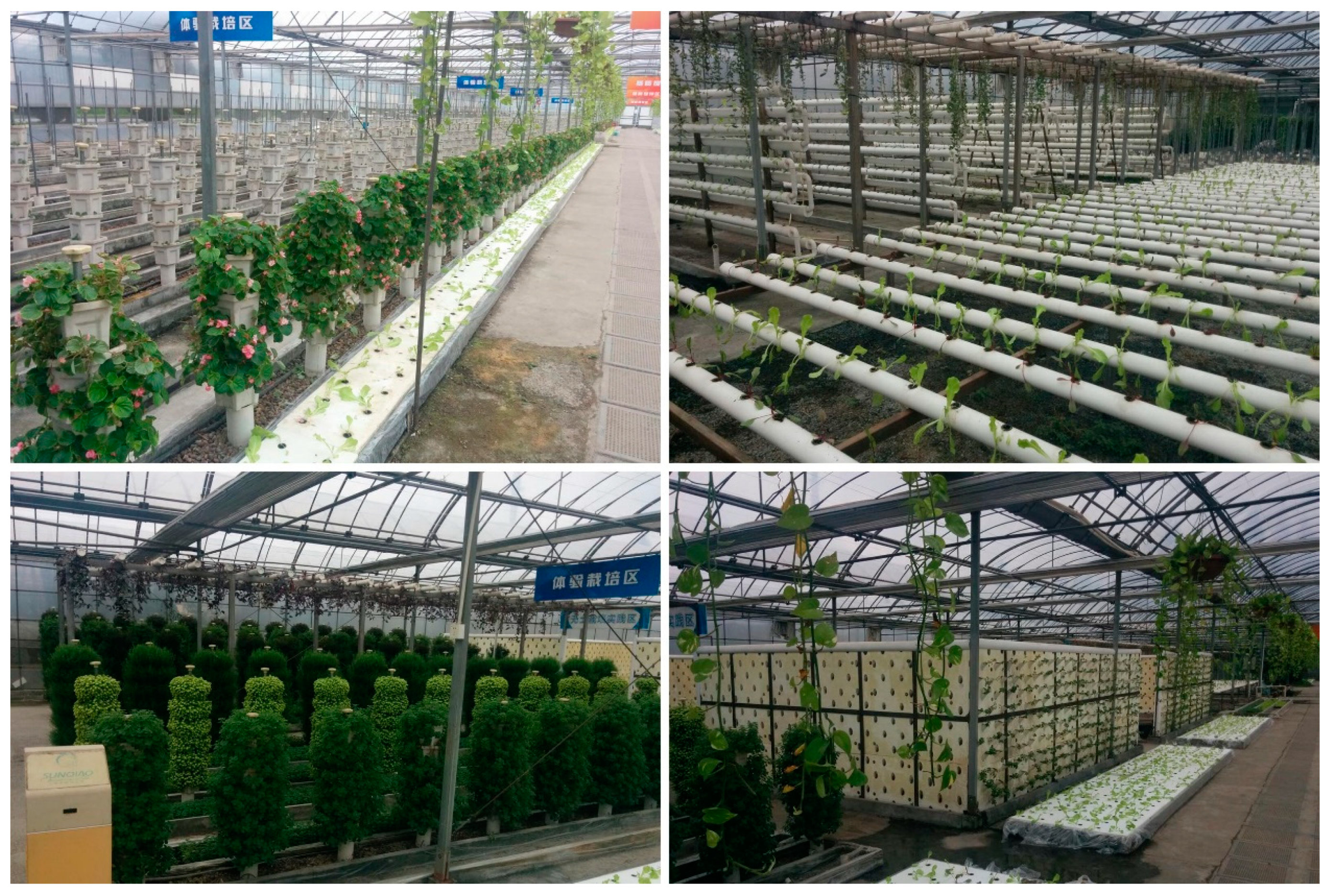
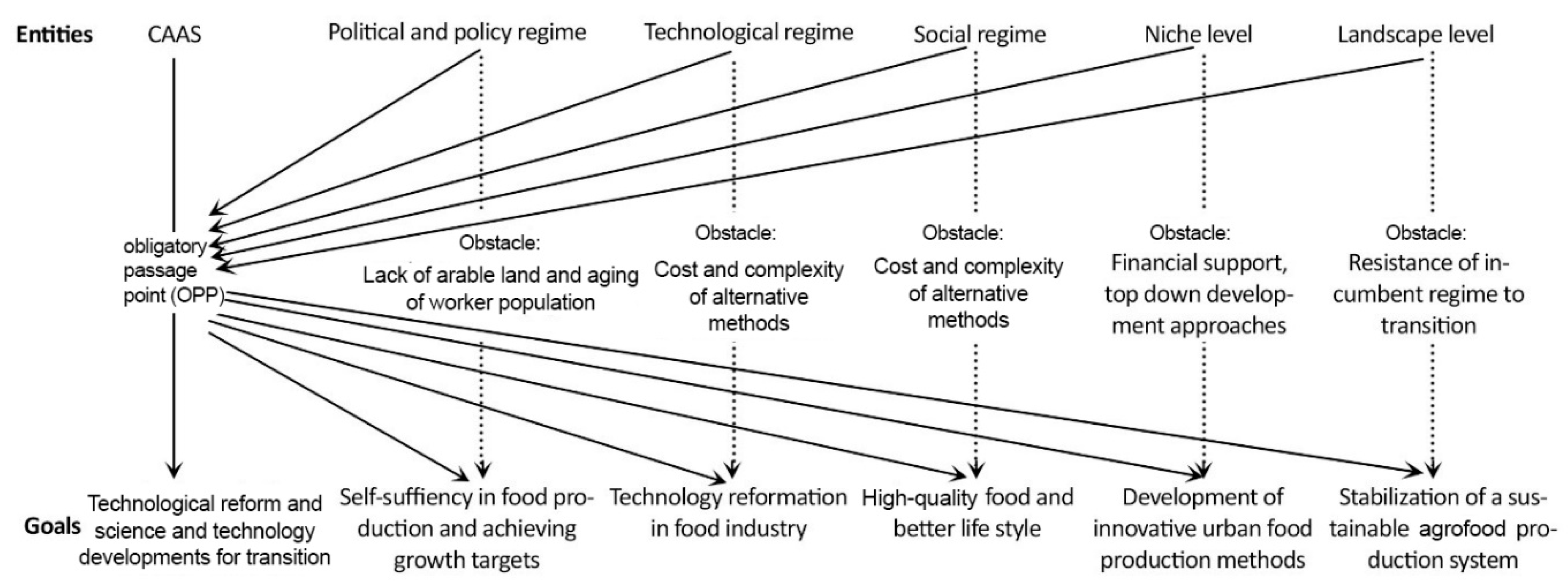
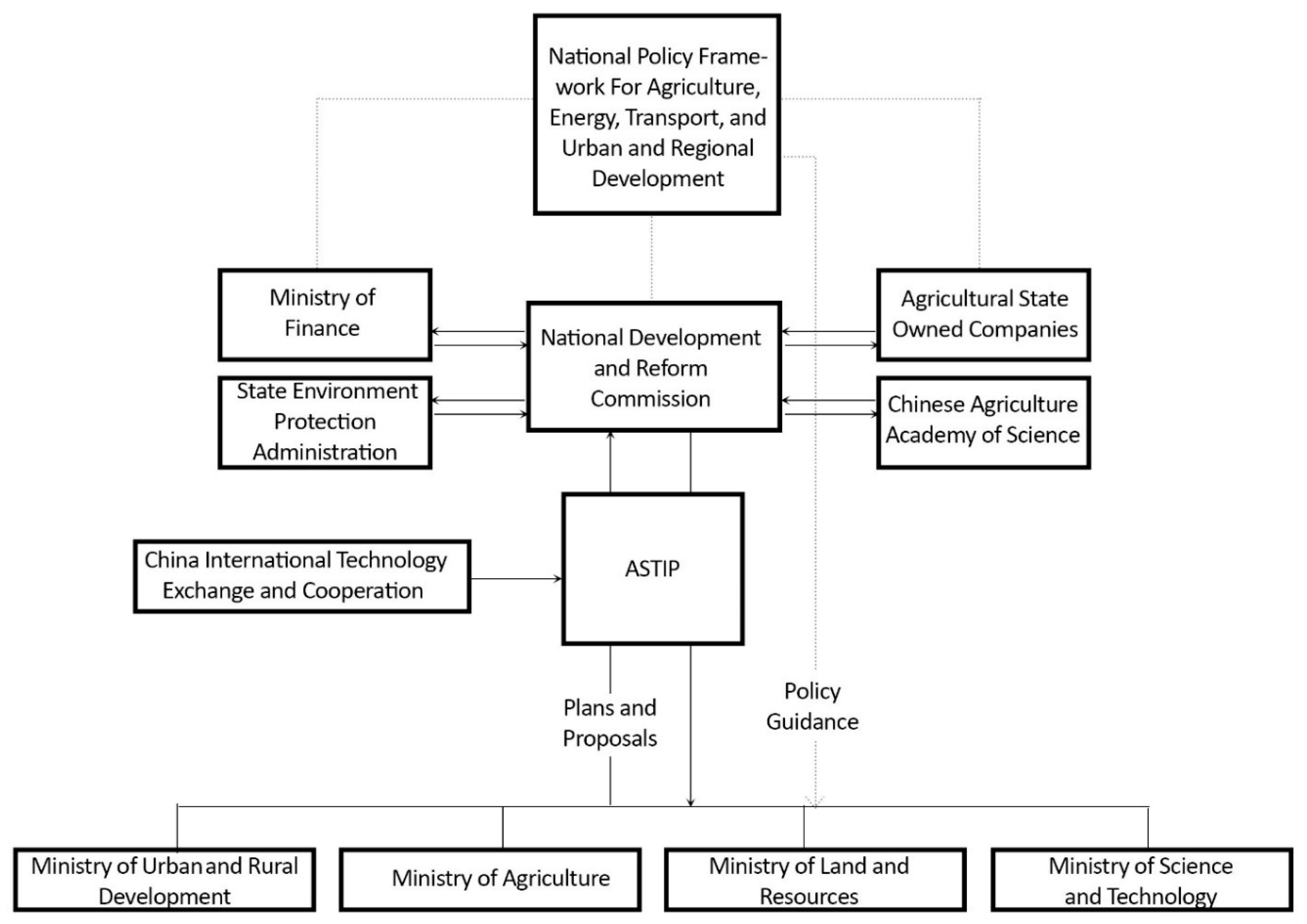
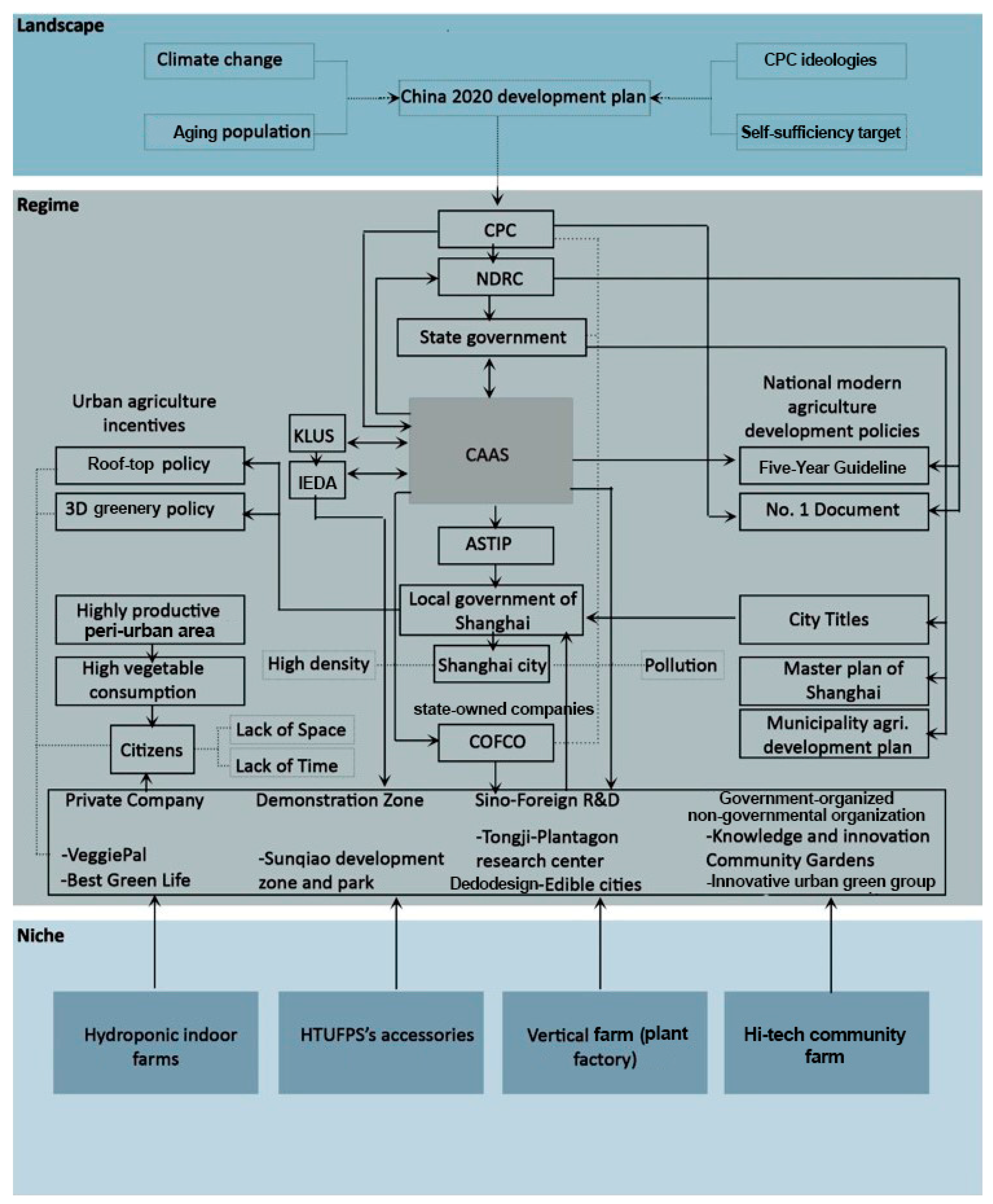
| Categorises | Actant | Abbreviation | Level | Main Role | Public/Private | Degree of Relevance |
|---|---|---|---|---|---|---|
| Human and associations | State Government | SG | National | Funding and subsidies | Public | 9 |
| China Academy of Agricultural Sciences | CAAS | National | Research and development | Public | 8 | |
| Institute of Environment and Sustainable Development in Agriculture | IEDA | National | Research and development | Public | 9 | |
| National Development Reform Commission | NDRC | National | Policy reformulation | Public | 7 | |
| Ministry of Agriculture | MoA | National | Implementation of policies | Public | 8 | |
| Ministry of Housing and Rural & Urban Development | MoHURD | National | Implementation of policies | Public | 7 | |
| Ministry of Science and Technology | MoST | National | Implementation of policies | Public | 6 | |
| Ministry of Land Resources | MoLR | National | Implementation of policies | Public | 6 | |
| Municipality of Shanghai | MSH | Local | Control and assessment of development plans | Public | 7 | |
| China National Cereals; Oils and Foodstuffs Corporation | COFCO | National | Funding, research and development | Public | 7 | |
| VeggiePal Ltd | VP | Local | Research and development | Private | 6 | |
| Best Green Life | BGL | Local | Research and development | Private | 6 | |
| Dedodesign-Edible Cities | DE | Local | Research | Private | 6 | |
| Innovative Urban Green | IUG | Local | Research | Private | 6 | |
| Urban Greenery Bureau | UGB | Local | Implementation of policies | Public | 7 | |
| Communist Party of China | CPC | National | Regulation of national policies and plans | Public | 9 | |
| Representative of nature | Land resources | LR | National | Pressure on regime | Public | 5 |
| Water resources | WR | National | Pressure on regime | Public | 5 | |
| Technologies (infrastructure, regulatory, accounting) | Five-Year guideline | FYG | National | Regulation of development strategies | Public | 8 |
| No. 1 document | NOD | National | Regulation of agricultural development plans | Public | 9 | |
| Tongji-Plantagon Research Centre | TPRC | Regional | Research center | Semi-public | 6 | |
| Hydroponics technologies | HS | National | Vegetable production technique | Private and public | 7 | |
| Vertical farming technologies | VF | National | Land and water efficient production technique | Private and public | 8 | |
| Vertical and roof gardening policy | VRP | Regional | Promotion of vertical farming and greening | Public | 8 | |
| Agricultural Science and Technology Innovation Program | ASTIP | National | Promoting and supporting agricultural technology development | Public | 9 | |
| Master Plan of Shanghai | MPSH | Regional | Regulation of spatial development | Public | 6 | |
| Municipal Agriculture Development Plan | MADP | Local | Regulation of agricultural land uses | Public | 6 | |
| Building and structure | Shanghai Metropolitan Area | SHMA | Regional | Spatial context | Public | 7 |
| Sunqiao Development Zone | SDZ | National | Spatial context for development of plant factories | Public | 8 | |
| Knowledge and Innovation Community Garden | KICG | Local | Community run urban agriculture facilities | Semi-public | 7 | |
| Key Laboratory Urban Agriculture South | KLUS | Regional | Research and development centres | Public | 7 |
| 1 Degree | 2 2local | 3 BonPwr | 4 2Step | 5 ARD | 6 Closene | 7 Eigen | 8 Betwee | 9 2StepBe | ||
|---|---|---|---|---|---|---|---|---|---|---|
| 1 | SG | 27.000 | 627.000 | 5266.988 | 27.000 | 27.000 | 27.000 | 0.210 | 3.477 | 3.477 |
| 2 | CAAS | 27.000 | 627.000 | 5266.988 | 27.000 | 27.000 | 27.000 | 0.210 | 3.477 | 3.477 |
| 3 | IEDA | 24.000 | 577.000 | 4825.271 | 27.000 | 25.500 | 30.000 | 0.193 | 1.714 | 1.714 |
| 4 | NDRC | 27.000 | 627.000 | 5266.988 | 27.000 | 27.000 | 27.000 | 0.210 | 3.477 | 3.477 |
| 5 | MoA | 26.000 | 608.000 | 5104.284 | 27.000 | 26.500 | 28.000 | 0.204 | 3.053 | 3.053 |
| 6 | MoHURD | 18.000 | 456.000 | 3780.851 | 27.000 | 22.500 | 36.000 | 0.151 | 0.199 | 0.199 |
| 7 | MoST | 23.000 | 559.000 | 4676.165 | 27.000 | 25.000 | 31.000 | 0.187 | 1.007 | 1.007 |
| 8 | MoLR | 22.000 | 542.000 | 4518.733 | 27.000 | 24.500 | 32.000 | 0.180 | 0.596 | 0.596 |
| 9 | MSH | 25.000 | 601.000 | 5033.456 | 27.000 | 26.000 | 29.000 | 0.201 | 1.1391 | 1.1391 |
| 10 | SHMA | 25.000 | 601.000 | 5033.456 | 27.000 | 26.000 | 29.000 | 0.201 | 1.1391 | 1.1391 |
| 11 | COFCO | 23.000 | 566.000 | 4720.412 | 27.000 | 25.000 | 31.000 | 0.189 | 0.703 | 0.703 |
| 12 | FYP | 27.000 | 627.000 | 5266.988 | 27.000 | 27.000 | 27.000 | 0.210 | 3.477 | 3.477 |
| 13 | NOD | 27.000 | 627.000 | 5266.988 | 27.000 | 27.000 | 27.000 | 0.310 | 3.477 | 3.477 |
| 14 | VP | 19.000 | 487.000 | 4033.232 | 27.000 | 23.000 | 35.000 | 0.161 | 0.043 | 0.043 |
| 15 | BGL | 19.000 | 485.000 | 4020.473 | 27.000 | 23.000 | 35.000 | 0.161 | 0.093 | 0.093 |
| 16 | SDZ | 22.000 | 543.000 | 4514.072 | 27.000 | 24.500 | 32.000 | 0.180 | 1.004 | 1.004 |
| 17 | TPRCDE | 14.000 | 354.000 | 2913.945 | 27.000 | 20.500 | 40.000 | 0.116 | 0.143 | 0.143 |
| 18 | KICG | 19.000 | 484.000 | 4005.234 | 27.000 | 23.000 | 35.000 | 0.160 | 0.255 | 0.255 |
| 19 | IUG | 14.000 | 350.000 | 2882.301 | 27.000 | 20.500 | 40.000 | 0.115 | 0.310 | 0.310 |
| 20 | HS | 24.000 | 570.000 | 4770.721 | 27.000 | 25.500 | 30.000 | 0.191 | 2.122 | 2.122 |
| 21 | VF | 26.000 | 610.000 | 5114.949 | 27.000 | 26.500 | 28.000 | 0.204 | 2.873 | 2.873 |
| 22 | VRP | 27.000 | 627.000 | 5266.988 | 27.000 | 27.000 | 27.000 | 0.210 | 3.477 | 3.477 |
| 23 | UGB | 24.000 | 579.000 | 4845.541 | 27.000 | 25.500 | 30.000 | 0.194 | 1.292 | 1.292 |
| 24 | ASTIP | 26.000 | 614.000 | 5150.852 | 27.000 | 26.500 | 28.000 | 0.206 | 2.441 | 2.441 |
| 25 | CPC | 27.000 | 627.000 | 5266.988 | 27.000 | 27.000 | 27.000 | 0.210 | 3.477 | 3.477 |
| 26 | MPSH | 20.000 | 485.000 | 4047.749 | 27.000 | 23.500 | 34.000 | 0.162 | 1.165 | 1.165 |
| 27 | MADP | 25.000 | 601.000 | 5033.456 | 27.000 | 26.000 | 29.000 | 0.201 | 1.391 | 1.391 |
| 28 | KLUS | 27.000 | 627.000 | 5266.988 | 27.000 | 27.000 | 27.000 | 0.210 | 3.477 | 3.477 |
| Type of HTUA | Practices | Stakeholders | Functions | Scale |
|---|---|---|---|---|
| Plant factories (urban development project) | Sunqiao modern agriculture zone | Pudong agriculture group, CAAS, COFCO, state government, Sasaki, Sunqiao Modern Agriculture United Development Co. Ltd. | Large-scale vegetable production, vertical farms, R&D center for plant factories, educational center, tourist attraction, urban–rural linking | Large |
| Household high-tech indoor gardens (development of materials) | VeggiePal | Private Technology University of Shanghai | Indoor farm for households and restaurants | Medium |
| Green farm | Private | Indoor farms | Small | |
| City crop | ||||
| Urban cultivator | ||||
| Keisue | ||||
| Everyday green | ||||
| Avatar | ||||
| Vegegrow | ||||
| Powerplant | ||||
| Home lohas | ||||
| Community high-tech agriculture (development of competences) | Knowledge and innovation community garden | GONGO | Community centers, education | Small |
| Jinshan High-tech Agriculture Exhibition Hall | Exhibition, education, community center | |||
| HTUA research and education facilities (creation of cultural meanings) | Jiaotong high-tech research farm | Jiaotong University, CAAS | Research center, education | |
| Tongji-Plantagon | Tongji University, Foreign firm | Research center, education | ||
| Edible cities | Sino-foreign firm | Urban design workshops and education | Medium | |
| Innovative Urban Green IUG | Tongji University, Municipal government | Urban planning education center | ||
| Dushi green Shanghai | CAAS, Shanghai Dushi Green Engineering CO., LTD | High-tech greenhouse research center |
© 2019 by the authors. Licensee MDPI, Basel, Switzerland. This article is an open access article distributed under the terms and conditions of the Creative Commons Attribution (CC BY) license (http://creativecommons.org/licenses/by/4.0/).
Share and Cite
Hosseinifarhangi, M.; Turvani, M.E.; van der Valk, A.; Carsjens, G.J. Technology-Driven Transition in Urban Food Production Practices: A Case Study of Shanghai. Sustainability 2019, 11, 6070. https://doi.org/10.3390/su11216070
Hosseinifarhangi M, Turvani ME, van der Valk A, Carsjens GJ. Technology-Driven Transition in Urban Food Production Practices: A Case Study of Shanghai. Sustainability. 2019; 11(21):6070. https://doi.org/10.3390/su11216070
Chicago/Turabian StyleHosseinifarhangi, Mohsen, Margherita E. Turvani, Arnold van der Valk, and Gerrit J. Carsjens. 2019. "Technology-Driven Transition in Urban Food Production Practices: A Case Study of Shanghai" Sustainability 11, no. 21: 6070. https://doi.org/10.3390/su11216070
APA StyleHosseinifarhangi, M., Turvani, M. E., van der Valk, A., & Carsjens, G. J. (2019). Technology-Driven Transition in Urban Food Production Practices: A Case Study of Shanghai. Sustainability, 11(21), 6070. https://doi.org/10.3390/su11216070





